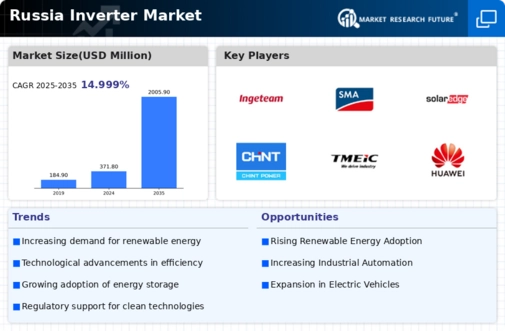Government Incentives for Renewable Energy
Government policies in Russia are increasingly favoring the adoption of renewable energy technologies, which in turn stimulates the inverter market. Various incentives, such as tax breaks and subsidies for solar and wind energy projects, are being implemented to encourage investment in clean energy. In 2025, it is estimated that the Russian government will allocate around $500 million towards renewable energy initiatives. These financial incentives not only promote the installation of renewable energy systems but also necessitate the use of advanced inverters, thereby driving growth in the inverter market. The supportive regulatory environment is expected to enhance market dynamics significantly.
Expansion of Electric Vehicle Infrastructure
The growing emphasis on electric vehicles (EVs) in Russia is poised to impact the inverter market positively. As the government and private sector invest in EV infrastructure, including charging stations, the demand for inverters is expected to rise. In 2025, the number of EV charging stations in Russia is anticipated to increase by over 30%, creating a substantial market for inverters that facilitate efficient energy conversion. This expansion not only supports the transition to cleaner transportation but also drives innovation in inverter technology, as manufacturers seek to develop solutions tailored for the evolving EV landscape. The synergy between EV growth and inverter demand is likely to shape the market's future.
Increasing Demand for Energy Storage Solutions
The inverter market in Russia is experiencing a notable surge in demand for energy storage solutions. This trend is primarily driven by the growing need for reliable power supply and the integration of renewable energy sources. As consumers and businesses seek to enhance energy efficiency, the adoption of battery storage systems is becoming more prevalent. In 2025, the energy storage market in Russia is projected to reach approximately $1.5 billion, indicating a robust growth trajectory. This increasing demand for energy storage solutions is likely to propel the inverter market, as inverters play a crucial role in managing energy flow between storage systems and the grid.
Technological Innovations in Power Electronics
Technological advancements in power electronics are significantly influencing the inverter market in Russia. Innovations such as improved semiconductor materials and enhanced control algorithms are leading to the development of more efficient and reliable inverters. In 2025, the market for advanced power electronics is projected to grow by approximately 15%, reflecting the increasing focus on energy efficiency and performance. These technological innovations not only enhance the functionality of inverters but also reduce costs, making them more accessible to a broader range of consumers. As the market evolves, the integration of cutting-edge technologies is expected to drive the inverter market forward, fostering a competitive landscape.
Rising Industrial Automation and Electrification
The trend towards industrial automation and electrification in Russia is contributing to the expansion of the inverter market. As industries increasingly adopt automated processes, the demand for efficient power management solutions is rising. In 2025, the industrial automation sector in Russia is projected to grow by approximately 10%, leading to a heightened need for inverters that can support various applications. This shift towards automation not only enhances productivity but also necessitates the integration of sophisticated inverter technologies, thereby driving the inverter market. The interplay between industrial growth and inverter technology is likely to create new opportunities for market players.
























Leave a Comment